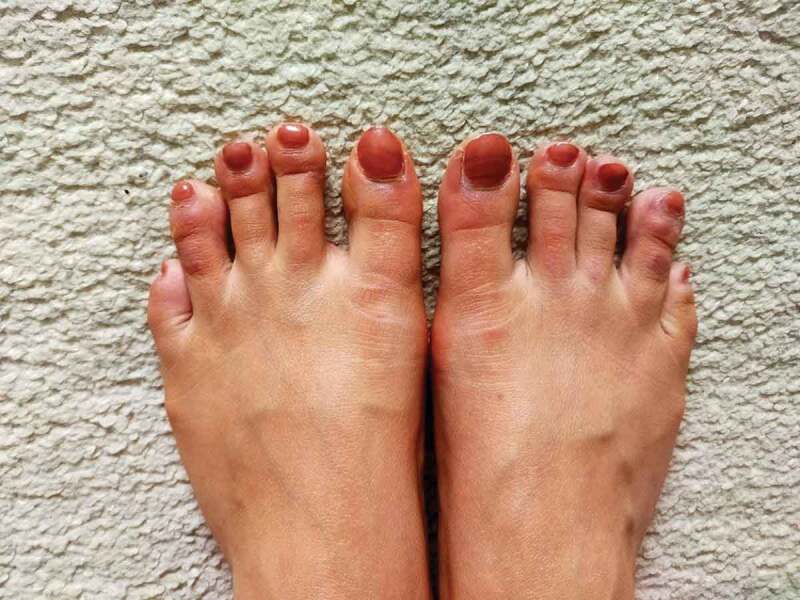ABSTRACT
Dermatological manifestations have shown to be associated with COVID-19 infections. The numbers of papers have quadrupled within May 2020 alone. One particular cutaneous manifestation named pseudo chilblains (COVID toe), expressed mostly in otherwise asymptomatic younger patients, has had particular media attention. Public health bodies, on the other hand, have been slow to recognize it as a symptom. This article will be discussing two case studies to demonstrate the lack of public knowledge and of public health guidance associated with this symptom. We will further explore the use of COVID toe in the epidemiology of COVID-19 and its utility as a sign for total cases and contact tracing.
KEYWORDS: Coronavirus, public health, cutaneous
Over recent months, there has been increased awareness of cutaneous manifestations of COVID-19. The literature has quadrupled within May alone, based on data from an initial literature review and a subsequent search of medical databases [1]. The pathophysiology of COVID-19 is to infect hosts through the angiotensin-converting enzyme 2 (ACE2) receptor. ACE2 receptors are expressed in major cell types, including endothelial cells within the patient vasculature. It has been postulated that the vascular symptoms and cutaneous manifestations are due to endotheliitis following endothelial cell derangement [2]. The largest study within the literature relating COVID-19 to dermatological symptoms constructed five main categories, of which one is named ‘pseudo chilblains’ [3], commonly known as ‘COVID toe’. It presents as peripheral areas of erythema and edema, sometimes alongside vesicles or pustules [3]. Patients suffer a milder systemic disease and dermatological symptoms begin commonly post-infection, with a mean age of 32.5 (SD: 21.8) and lasting on average 12.7 days [3]. It has yet to be established why the younger population are more susceptible to these particular manifestations.
Case studies
Having read the recent media coverage, two household members (A and B, 23, of both sexes) realized that easily overlooked, ongoing rashes on their left foot may have been related to COVID-19. The rashes (3 mm, erythematous plaque, highly pruritic, tender and non-blanching) lasted for approximately ten days, with both cases being most prominent on the second distal interphalangeal joint. The rash was likened to Figure 4 in Landa, N. et al., ‘Chilblain-like lesions on feet and hands during the COVID-19 Pandemic’ [4]. Member A had no other symptoms; however, member B had a dry, erythematous rash located on the cheeks and mandibular area.
These symptoms prompted contact with friends (aged 23–26) with some sharing experiences of rashes, having made no association to COVID-19. One friend (female, 25) provided Figure 1, taken approximately eight weeks after the initial onset of the rash. She experienced the previously described lesions, which became purpuric and resolved after approximately six weeks leaving dry patches. She was mildly breathless on low exertion and had a dry, red facial rash. Other household members only displayed a mild sore throat.
Figure 1.

Image of pseudo chilblains of both feet, in a 25-year-old patient, after 8 weeks of rash onset.
No cases had previous medical conditions, self-administered medication or sought medical help. Cases were self-limiting, with varying durations. Younger patients may find it hard to realize that they have had COVID-19, as they may experience the rash as a lone symptom [5]. This condition may contribute to underestimating the true extent of COVID-19 within a population.
As pseudo chilblains more commonly appear post-infection, it could be a useful epidemiological marker for infection in the younger population [3]. A review of English-speaking public health bodies showed that only the World Health Organization included dermatological manifestations as a symptom. Here in the UK, we question whether the National Health Service will list this symptom online, due to their slow addition of anosmia and loss of taste symptoms [6]. A Track and Trace contact tracing app is due to launch this month, and the inclusion of the common rashes associated with COVID-19 would aid in contact tracing of the UK population.
Funding Statement
There were no sources of funding to declare.
Disclosure statement
No potential conflict of interest was reported by the authors.
Consent
Consent for publication has been obtained.
Data availability
Data sharing is not applicable to this article as no datasets were generated or analyzed during the current study.
References
- [1].Sachdeva M, Gianotti R, Shah M, et al. Cutaneous manifestations of COVID-19: report of three cases and a review of literature. J Dermatol Sci. 2020;98(2):75–81. DOI: 10.1016/j.jdermsci.2020.04.011 [DOI] [PMC free article] [PubMed] [Google Scholar]
- [2].Varga Z, Flammer AJ, Steiger P, et al. Endothelial cell infection and endotheliitis in COVID-19. Lancet. 2020;395(10234):1417–1418. DOI: 10.1016/S0140-6736(20)30937-5 [DOI] [PMC free article] [PubMed] [Google Scholar]
- [3].Galván Casas C, Català A, Carretero Hernández G, et al. Classification of the cutaneous manifestations of COVID-19: a rapid prospective nationwide consensus study in Spain with 375 cases. Br J Dermatol. 2020. Available from: https://www.ncbi.nlm.nih.gov/pubmed/32348545 [DOI] [PMC free article] [PubMed] [Google Scholar]
- [4].Landa N, Mendieta‐Eckert M, Fonda‐Pascual P, et al. Chilblain‐like lesions on feet and hands during the COVID‐19 pandemic. Int J Dermatol. 2020;59:739–743. Available from: https://onlinelibrary.wiley.com/doi/abs/10.1111/ijd.14937 [DOI] [PMC free article] [PubMed] [Google Scholar]
- [5].Mazzotta F., Troccoli T.. 2020. Acute acro-ischemia in the child at the time of COVID-19. Eur. J.Pediat. Dermatol. 30 (2): 71-74. doi: 10.26326/2281-9649.30.2.2102 [DOI] [Google Scholar]
- [6].Statement from the UK Chief Medical Officers on an update to coronavirus symptoms. 2020. May 18. Available from: https://www.gov.uk/government/news/statement-from-the-uk-chief-medical-officers-on-an-update-to-coronavirus-symptoms-18-may-2020.
Associated Data
This section collects any data citations, data availability statements, or supplementary materials included in this article.
Data Availability Statement
Data sharing is not applicable to this article as no datasets were generated or analyzed during the current study.


